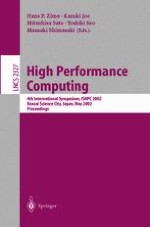2002 | OriginalPaper | Buchkapitel
Improving InfiniBand Routing through Multiple Virtual Networks
verfasst von : J. Flich, P. López, J. C. Sancho, A. Robles, J. Duato
Erschienen in: High Performance Computing
Verlag: Springer Berlin Heidelberg
Enthalten in: Professional Book Archive
Aktivieren Sie unsere intelligente Suche, um passende Fachinhalte oder Patente zu finden.
Wählen Sie Textabschnitte aus um mit Künstlicher Intelligenz passenden Patente zu finden. powered by
Markieren Sie Textabschnitte, um KI-gestützt weitere passende Inhalte zu finden. powered by
InfiniBand is very likely to become the de facto standard for communication between nodes and I/O devices (SANs) as well as for interprocessor communication (NOWs). The InfiniBand Architecture (IBA) defines a switch-based network with point-to-point links whose topology is arbitrarily established by the customer. Often, the interconnection pattern is irregular. Up*/down* is the most popular routing scheme currently used in NOWs with irregular topologies. However, the main drawbacks of up*/down* routing are the unbalanced channel utilization and the difficulties to route most packets through minimal paths, which negatively affects network performance. Using additional virtual lanes can improve up*/down* routing performance by reducing the head-of-line blocking effect, but its use is not aimed to remove its main drawbacks. In this paper, we propose a new methodology that uses a reduced number of virtual lanes in an efficient way to achieve a better traffic balance and a higher number of minimal paths. This methodology is based on routing packets simultaneously through several properly selected up*/down* trees. To guarantee deadlock freedom, each up*/down* tree is built over a different virtual network. Simulation results, show that the proposed methodology increases throughput up to an average factor ranging from 1.18 to 2.18 for 8, 16, and 32-switch networks by using only two virtual lanes. For larger networks with an additional virtual lane, network throughput is tripled, on average.
